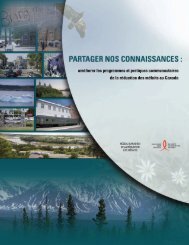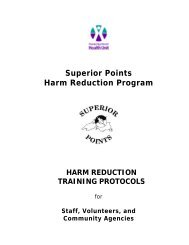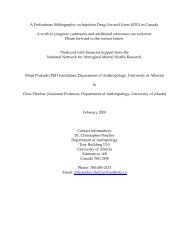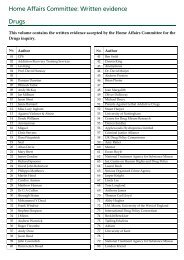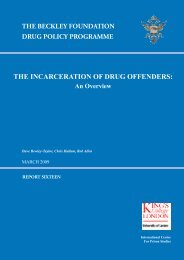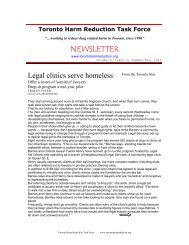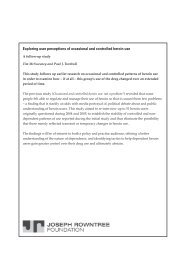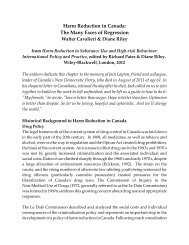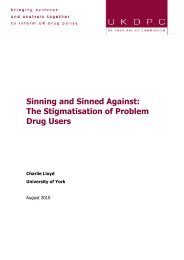Canadian Journal Addiction Medicine - Canadian Harm Reduction ...
Canadian Journal Addiction Medicine - Canadian Harm Reduction ...
Canadian Journal Addiction Medicine - Canadian Harm Reduction ...
Create successful ePaper yourself
Turn your PDF publications into a flip-book with our unique Google optimized e-Paper software.
November 2012<br />
about drug use. Youth specific screening tools and brief<br />
interventions for primary care and focused practice addictions<br />
settings will be discussed. Communication with parents and<br />
confidentiality issues will also be reviewed.<br />
ADHD and ADDICTION<br />
Dr. Tim Bilkey, Hons.B.Sc.,M.D.,F.R.C.P.(C)<br />
Ontario Bilkey ADHD Clinic<br />
Many people with Attention Deficit Hyperactivity Disorder<br />
(ADHD) struggle with addiction. There is a bidirectional<br />
overlap between ADHD and addictions. Cigarette smoking is<br />
a gateway drug to the later development of other addictions<br />
in untreated ADHD. Nicotine and cocaine both raise<br />
dopamine in the central nervous system as stimulants. In<br />
cocaine dependent adults there is a rate of ADHD between<br />
10% and 35%. In alcohol dependent people there is a rate<br />
of ADHD between 33% and 71%. Up to 71% of ADHD<br />
adults smoke cigarettes and maternal smoking has been<br />
linked to the development of ADHD. Untreated ADHD and<br />
addictions lead to impairments such as increased DUIs and<br />
antisocial outcomes. This workshop explores the relationship<br />
between ADHD and addictions and the approaches to<br />
multimodal treatments. Recent research indicates that ADHD<br />
and addictions should be treated as separate conditions<br />
and monitored closely. Achieving abstinence in terms of<br />
the addiction is a first step towards recovery, followed by<br />
multimodal treatment approaches for ADHD.<br />
Substance Use Disorders:<br />
Neurosciences, Research &<br />
Treatment Implications<br />
Dr. Frank Vaccarino<br />
Principal at University of Toronto Scarborough<br />
This presentation will cover a variety of topics relating to<br />
our current knowledge of the neuroscience of Substance<br />
Use Disorders (SUD). The role of biology and brain<br />
in understanding substance use and abuse has been a<br />
major area of study over the past 30 years. However, it<br />
is only recently that a sufficient amount of knowledge<br />
has accumulated to permit a comprehensive view of the<br />
neuroscience of SUD. This presentation will provide an<br />
overview of current knowledge relating to our understanding<br />
of the neural basis of SUD. Issues relating to the question<br />
of a common neural pathway for different drug rewards and<br />
the role of dopamine are featured in the presentation. As<br />
well, more recent developments in our understanding of the<br />
neurobiology of SUD in humans are highlighted, including<br />
findings pertaining to sensitization, conditioning, and<br />
developmental considerations. Finally, new emerging areas<br />
of research that have the potential to impact on treatment<br />
and prevention strategies will also be discussed.<br />
When Hoof Beats mean<br />
Horses AND Zebras: Treating<br />
Concurrent Disorders in 2012<br />
Dr. William Jacyk<br />
Chief Medical Consultant to Greene Stone Muskoka<br />
There is ever increasing awareness that Substance Use<br />
Disorders and <strong>Addiction</strong>s do not exist in isolation and that<br />
frequently a concurrent mental health disorder may emerge.<br />
Conventional wisdom once said, “treat the addiction first<br />
and address the other later” which was often valid for those<br />
who were primarily chemically dependent or addicted<br />
and developed symptoms secondarily as their addiction<br />
progressed. However, there were and are those more complex<br />
circumstances where developmental and adult traumatic<br />
stress, depression and anxiety antedated the appearance<br />
of the substance use and abuse and these symptoms may<br />
emerge and complicate their progress in early recovery.<br />
This presentation will discuss the treatment approach when<br />
symptoms of a concurrent disorder emerge in a residential<br />
treatment program where staff are prepared to address the<br />
classical symptoms of the addiction plus attempt to support<br />
and stabilize individuals who are experiencing the emergence<br />
of symptoms which are related to concurrent disorders that<br />
can create confusion and impede the progress of recovery.<br />
The collective challenge in this setting is developing the<br />
wisdom to know the difference and relieving the constellation<br />
of symptoms that demand individual attention. The core<br />
components of this approach will be described and how these<br />
are integrated with a traditional Twelve-Step facilitation will<br />
be discussed.<br />
Canada’s National Low Risk<br />
Drinking Guidelines: The<br />
Scientific Basis, the Numbers<br />
and the Challenges for Uptake<br />
Peter R. Butt MD CCFP (EM) FCFP, Associate Professor,<br />
Department of Family <strong>Medicine</strong>, University of<br />
Saskatchewan and Chair, CCSA Expert Advisory Panel,<br />
National Low Risk Drinking Guidelines<br />
The National Alcohol Strategy (CCSA, 2007) called for the<br />
development and promotion of national drinking guidelines<br />
to encourage a culture of moderation, and aim for consistency<br />
and clarity of alcohol-related health and safety messages.<br />
18



